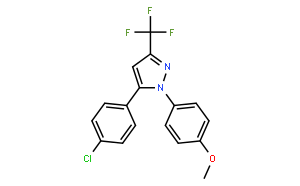| Cas No.: | 188817-13-2 |
| Chemical Name: | 5-(4-Chlorophenyl)-1-(4-methoxyphenyl)-3-(trifluoromethyl)-1H-pyrazole |
| Synonyms: | 1H-Pyrazole,5-(4-chlorophenyl)-1-(4-methoxyphenyl)-3-(trifluoromethyl)-;5-(4-Chlorophenyl)-1-(4-methoxyphenyl)-3-(trifluoromethyl)-1H-pyrazole;SC-560;5-(4-chlorophenyl)-1-(4-methoxyphenyl)-3-(trifluoromethyl)pyrazole;SC 560;SC-560 Assay Reagent;5-(4-Chlorophenyl)-1-(4-methoxyphenyl)-3-trifluoromethyl pyrazole;Ionomycin calcium salt;Lopac-S-2064;5-(4-Chlorophenyl);5-(4-Chlorophenyl)-3-(trifluoromethyl)-1-(4-methoxyphenyl)-1H-pyrazole;razole;SC560;5-(4-Chlorophenyl)-1-(4-methoxyphenyl)-3-trifluoromethylpyrazole;1H-Pyrazole, 5-(4-chlorophenyl)-1-(4-methoxyphenyl)-3-(trifluoromethyl)-;Lopac0_001086;GTPL10240;BDBM13065;QC |
| SMILES: | COC1=CC=C(C=C1)N2C(=CC(C(F)(F)F)=N2)C3=CC=C(Cl)C=C3 |
| Formula: | C17H12ClF3N2O |
| M.Wt: | 352.7382 |
| Purity: | >98% |
| Sotrage: | 2 years -20°C Powder, 2 weeks 4°C in DMSO, 6 months -80°C in DMSO |
| Description: | SC-560 is a potent and selective COX-1 inhibitor with an IC50 of 9 nM. |
| Target: | COX-1:9 nM (IC50) COX-2:6.3 μM (IC50) |
| In Vivo: | Oral dosing with either 10 or 30 mg/kg SC-560 1 hour before assay completely inhibits ionophore-stimulated TxB2production, indicating that SC-560 is orally bioavailable and inhibits COX-1 in vivo[1]. SC-560 extensively distributes into rat tissues, and has a CL approaching hepatic plasma flow. The drug displays low less than 15% and formulation dependent bioavailability after oral administration and demonstrates kidney toxicity[3]. |
| In Vitro: | Preincubation of COX-1 with SC-560 inhibits the conversion of arachidonic acid to PGE2 in a concentration-dependent manner. The IC50 of SC-560 for COX-2 is 6.3 μM, nearly 1,000-fold higher than with COX-1[1]. SC-560 shows a dose and time dependent inhibitory effect on HCC cell growth. SC-560 also inhibits colony formation in soft agar and induces apoptosis in HCC cells in a dose-dependent manner. Moreover, SC-560 decreases the levels of the anti-apoptotic proteins survivin and XIAP and activates caspase 3 and 7 in a dose and time dependent fashion[2]. |
| Cell Assay: | HuH-6 and HA22T/VGH cells (5000/well) are treated with various concentrations of SC-560 (5, 10, 25, 50, 100, 200 μM) and cultured for 72 h. At the end of treatment, cell viability is assessed by MTS assay[2]. |
| Animal Administration: | Rats: The pharmacokinetics of SC-560 is studied in Sprague-Dawley rats after a single intravenous (i.v.) and oral dose (10 mg/kg) in polyethylene glycol (PEG) 600 and a single oral dose (10 mg/kg) in 1% methylcellulose (MC). Serial blood samples are collected via a catheter inserted in the right jugular vein and serum samples are analysed for SC-560 using reverse phase HPLC. After oral administration of SC-560 in PEG, urine is also collected for 24 h and analyzed for urinary sodium, chloride, and potassium as well as NAG[3]. |
| References: | [1]. Smith CJ, et al. Pharmacological analysis of cyclooxygenase-1 in inflammation. Proc Natl Acad Sci U S A. 1998 Oct 27;95(22):13313-8. [2]. Lampiasi N, et al. The selective cyclooxygenase-1 inhibitor SC-560 suppresses cell proliferation and induces apoptosis in human hepatocellular carcinoma cells. Int J Mol Med. 2006 Feb;17(2):245-52. [3]. Teng XW, et al. Formulation dependent pharmacokinetics, bioavailability and renal toxicity of a selective cyclooxygenase-1 inhibitor SC-560 in the rat. J Pharm Pharm Sci. 2003 May-Aug;6(2):205-10. |

 DC Chemicals' products qualify for U.S. tariff exemptions. We guarantee no price increases due to customs duties and maintain stable supply, continuing to deliver reliable research solutions to our American clients.
DC Chemicals' products qualify for U.S. tariff exemptions. We guarantee no price increases due to customs duties and maintain stable supply, continuing to deliver reliable research solutions to our American clients.





















